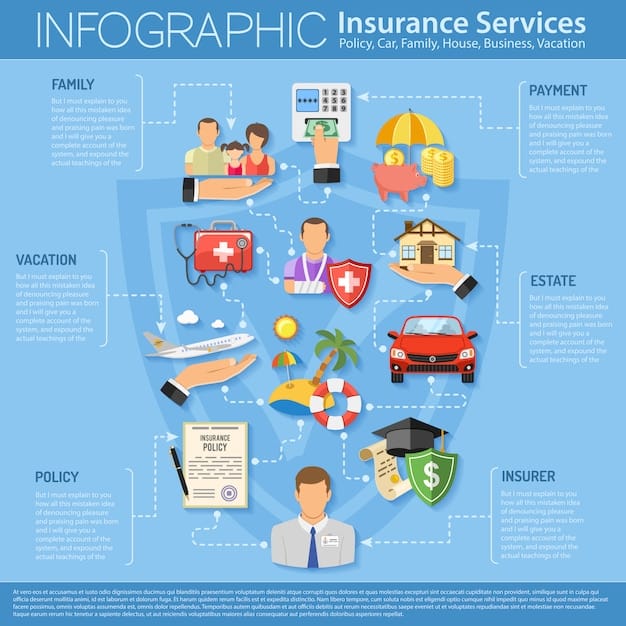Tax Implications of Employee Benefits: Your 2025 Guide

Understanding the tax implications of your employee benefits is crucial for financial planning; this guide for 2025 clarifies how various benefits, such as health insurance, retirement plans, and flexible spending accounts, are taxed, enabling informed decisions and maximizing after-tax income.
Navigating the complexities of employee benefits can be challenging, especially when it comes to taxes. Understanding the tax implications of your employee benefits: A comprehensive guide for 2025 is crucial for making informed decisions about your compensation package and ensuring you’re maximizing your after-tax income. Let’s delve into how various benefits are taxed and how you can leverage this knowledge for better financial planning.
Decoding Your Employee Benefits Package: A Tax Perspective
Employee benefits are a valuable part of your overall compensation, but they’re not always as straightforward as your salary. Understanding how these benefits are taxed can help you make smarter choices and avoid surprises come tax season. This section will break down the basics of employee benefits and how they interact with taxes.
Common Types of Taxable and Non-Taxable Benefits
Many employee benefits come with tax advantages, while others are considered taxable income. Knowing the difference is the first step in effective tax planning.
- Health Insurance: Generally, employer-sponsored health insurance premiums are tax-free to the employee.
- Retirement Plans (401(k), etc.): Contributions are often pre-tax, reducing your current taxable income, but withdrawals in retirement are taxed.
- Life Insurance: Employer-paid premiums for basic life insurance are typically tax-free up to a certain amount.
- Disability Insurance: If you pay the premiums with after-tax dollars, benefits are usually tax-free. If your employer pays the premiums, benefits are generally taxable.
Understanding these distinctions allows you to plan your contributions and coverage effectively, optimizing your tax situation.

Health Benefits: Navigating Tax-Advantaged Healthcare
Health benefits are a cornerstone of most employee benefits packages. From health insurance to flexible spending accounts, understanding the tax implications of these benefits can significantly impact your healthcare expenses and overall tax liability. Let’s examine these in detail.
Health Savings Accounts (HSAs) and Taxes
Health Savings Accounts (HSAs) offer a triple tax advantage: contributions are tax-deductible, earnings grow tax-free, and withdrawals for qualified medical expenses are tax-free. This makes HSAs a powerful tool for managing healthcare costs.
To be eligible for an HSA, you must be enrolled in a high-deductible health plan (HDHP). Contributions can be made by you, your employer, or both.
Flexible Spending Accounts (FSAs) and Their Tax Benefits
Flexible Spending Accounts (FSAs) allow you to set aside pre-tax dollars for eligible healthcare or dependent care expenses. However, FSAs typically have a “use-it-or-lose-it” rule, meaning you must spend the funds within the plan year or forfeit them.
- Healthcare FSA: Used for medical, dental, and vision expenses.
- Dependent Care FSA: Used for childcare expenses, allowing you to pay for daycare or after-school programs with pre-tax dollars.
Properly utilizing FSAs can lead to significant tax savings, but careful planning is necessary to avoid forfeiting unused funds.
In conclusion, health benefits offer numerous tax advantages that can help you save money on healthcare expenses while reducing your overall tax burden.
Retirement Planning: Tax-Efficient Strategies for the Future
Retirement planning is a critical aspect of financial security, and employee benefits play a significant role in achieving your retirement goals. Understanding the tax implications of retirement plans can help you maximize your savings and minimize your tax liability during your working years and in retirement.
401(k) Plans: Tax Advantages and Considerations
401(k) plans are one of the most common employee retirement benefits. They offer tax-deferred growth, meaning you don’t pay taxes on investment earnings until you withdraw the money in retirement. Many employers also offer matching contributions, which can significantly boost your retirement savings.
There are two main types of 401(k) plans: traditional and Roth. Traditional 401(k) contributions are made pre-tax, reducing your current taxable income. Roth 401(k) contributions are made with after-tax dollars, but withdrawals in retirement are tax-free.
Pensions and Other Retirement Benefits
In addition to 401(k) plans, some employers offer pensions or other retirement benefits. The tax treatment of these benefits can vary depending on the specific plan rules.
Generally, pension payments are taxed as ordinary income in retirement. However, some pensions may offer a lump-sum distribution option, which can have different tax implications.

Life and Disability Insurance: Tax Considerations
Life and disability insurance are essential components of a comprehensive employee benefits package, providing financial protection for you and your family in the event of unforeseen circumstances. Understanding the tax implications of these benefits is crucial for making informed decisions about your coverage.
Tax Implications of Premiums and Benefits
The taxability of life and disability insurance benefits depends on who pays the premiums. If your employer pays the premiums for basic life insurance coverage (up to $50,000), the benefit is generally tax-free to you. However, if your employer pays premiums for coverage above $50,000, the excess is considered taxable income.
For disability insurance, if you pay the premiums with after-tax dollars, the benefits are usually tax-free. However, if your employer pays the premiums, the benefits are generally taxable.
Strategies for Maximizing Tax Advantages
One strategy for maximizing tax advantages is to pay for your own disability insurance premiums with after-tax dollars, ensuring that any benefits you receive are tax-free. Another strategy is to carefully consider the amount of life insurance coverage you need and determine whether it’s more tax-efficient to purchase additional coverage through your employer or on your own.
In conclusion, life and disability insurance provide valuable financial protection, but understanding the tax implications of these benefits is essential for making informed decisions.
Dependent Care Benefits: Tax Relief for Families
Dependent care benefits can provide significant tax relief for families with children or other dependents requiring care. These benefits allow you to set aside pre-tax dollars to pay for eligible care expenses, reducing your taxable income and overall tax liability.
Understanding Dependent Care FSAs
Dependent Care FSAs allow you to contribute pre-tax dollars to pay for eligible dependent care expenses, such as childcare, daycare, or after-school programs. The maximum amount you can contribute to a Dependent Care FSA is typically capped by the IRS.
- Eligibility Requirements: To be eligible for a Dependent Care FSA, both you and your spouse (if married) must be employed or attending school full-time.
- Eligible Expenses: Eligible expenses include childcare expenses that enable you to work or attend school.
- Tax Savings: By contributing to a Dependent Care FSA, you can reduce your taxable income and save on taxes.
Careful planning is necessary to ensure you don’t forfeit any unused funds at the end of the plan year.
Education Assistance Programs: Tax-Free Learning Opportunities
Education assistance programs are a valuable employee benefit that can help you pursue further education or training without incurring additional tax liability. These programs allow employers to provide tax-free educational assistance to their employees, up to a certain limit.
Employers can provide up to $5,250 per year in tax-free educational assistance to their employees. This assistance can cover tuition, fees, books, and supplies for undergraduate or graduate courses.
Other Employee Benefits: Tax Perks to Consider
Beyond the common benefits like health insurance and retirement plans, there are other employee perks that can offer tax advantages. Understanding these can help you make the most of your compensation package.
Commuting Benefits
Some employers offer commuting benefits, such as transportation vouchers or parking reimbursement. Certain amounts of these benefits can be excluded from your taxable income.
Wellness Programs
Wellness programs that promote employee health can sometimes offer tax-free benefits, like gym memberships or health screenings.
By taking advantage of various employee benefits and understanding their tax implications, you can optimize your financial well-being and ensure you’re making informed decisions.
| Key Benefit | Brief Description |
|---|---|
| 🏥 Health Insurance | Premiums are often tax-free, reducing your taxable income. |
| 💰 401(k) Plans | Pre-tax contributions lower your current taxable income, with deferred growth. |
| 👨👩👧👦 Dependent Care FSA | Pre-tax contributions for childcare expenses save on taxes. |
| 📚 Education Assistance | Up to $5,250 per year can be tax-free for tuition and related expenses. |
Frequently Asked Questions
▼
Generally, employer-sponsored health insurance premiums are not considered taxable income to the employee. This is a significant tax advantage.
▼
Traditional 401(k) contributions are made pre-tax, reducing your current taxable income. Roth 401(k) contributions are made after-tax, with tax-free withdrawals in retirement.
▼
An HSA is a tax-advantaged savings account used for healthcare expenses. Contributions are tax-deductible, earnings grow tax-free, and withdrawals for qualified medical costs are tax-free.
▼
Employer-paid premiums for basic life insurance (up to $50,000) are typically tax-free. Coverage above this amount may be considered taxable income.
▼
Dependent Care FSAs allow you to set aside pre-tax dollars for eligible childcare expenses, reducing your taxable income. Careful planning is needed to avoid forfeiting unused funds.
Conclusion
Understanding the tax implications of your employee benefits is crucial for effective financial planning. By familiarizing yourself with how different benefits are taxed, you can make informed decisions that optimize your financial well-being and minimize your tax liability in 2025 and beyond.





